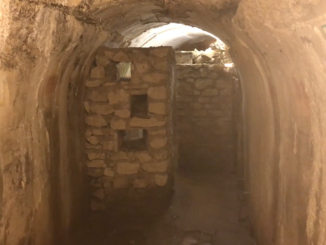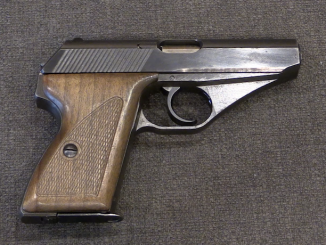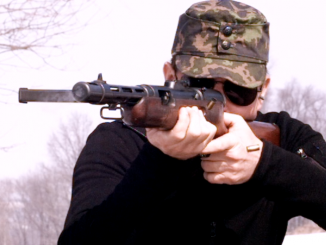The P7 was one of the most interesting and original handgun designs of the last few decades. Originally created for West German police trials, it was chambered in 9x19mm. As it became popular beyond Germany, the question arose of it being offered in additional calibers. The P7M10 was released in .40 S&W (that’s a story for a different video), but it was never put into serial production in .45 ACP, despite H&K USA pushing heavily for it.
On the technical side, the .45 ACP cartridge caused problems with the design’s gas-delay system. It simply did not work reliably with the bullet weight and gas pressure of the .45 cartridge. Instead, H&K engineers replaced the gas piston with a hydraulic buffer or damper. However, only a total of 6 prototype were made in the mid 1980s, as the German branch of the company was against its production (presumably because they did not think it would sell well enough to justify the production retooling costs it would require). I believe this example (serial number 2) is the only one in the United States today.




Is there really any advantage to a .45 ACP pistol of this size compared to a 9mm version? At the effective range of this type of pistol, it seems like the higher capacity and easier handling of the 9mm would outweigh any possible advantage in stopping power from the .45 ACP. And that’s not even looking at the high efficacy self-defense ammunition companies like Hornady are putting out.
Without going into discussion “9×19 mm Parabellum vs .45 Auto” bazillion-th time, I want yo note that H&K’s decision makers, answered question: will we get profit from introducing P7 in .45 Auto to market? So they were more concerned with what users perceive they need, not factual performance.
Neither Hornady, nor anyone else, was making high efficacy 9mm ammo in 1983, so proposing to make a pistol in 45 ACP was not an outrageous idea in and of itself at the time.
But as Ian said, H&K wanted to market to police forces. And the few American police forces (and SWAT teams) issuing a 45 ACP would likely just issue a Colt 1911 and be done with it. Most American police forces in the early 1980’s thought that 45 ACP kicked too hard, and they were still mostly sticking to revolvers anyway.
Why not just make an original larger handgun in 45 ACP rather than an “overgrown pocket protector?” Sorry, couldn’t resist making a bad joke.
That’s pretty much how the H und K USP .45 came about. Then everybody realized it was basically a polymer-framed SiG P220 .45 with a 1911 safety and higher MSRP.
Ford Mustangs outsell Dodge Challengers mostly because they’re cheaper, not necessarily because they’re better.
cheers
eon
They’re also a lot more comfortable & all-around practical. Challenger’s just a sedan with 2 doors 😉
They also don’t have a speaker cone instead of engine noise.
This was just a year before Smith & Wesson showed up with .45 ACP versions of the 39/59 family, which became VERY popular with US police forces. The Sig P220 had been available in the US in .45ACP since the 1970s. And most agencies that were willing to approve semiauto pistols WERE NOT willing to allow the scary looking “cocked and locked” 1911 to be worn on duty.
HK realized there was a market for .45ACP handguns in the US that weren’t 1911s. And such a market existed.
HK had *literally* just started responding to US market interests with modifications to the P7 to appeal to US civilian and police buyers.
But, remember, they had trouble marketing the P7 in it’s original caliber to US police forces, even though it was widely lauded as the “perfect’ police semiauto.
All P7 concept might be outlined as “Theory meets practice… Resulting dissapointment”… lMHO.
Your opinion, humble or otherwise, continues to gain my respect.
Did someone mention hydrolic buffers at some point?! How is that the technology used in suspension and shock-absorption for vehicles has seen so little application in lethal devices?
Little?
And what about artillery pieces?
Generally, the laws of fluid dynamics dictate that hydraulic systems work best in applications allowing a relatively high fluid volume and a relatively long-duration dwell time for movement.
An artillery recoil or equilibrator system is pretty much a classic case of both. Fluid volume can be high, as you’re dealing with a large moving mass which has to have its motion controlled; back and forth for recoil, up and down for equilibrator.
Dwell time is relatively long, because of Newton’s Three Laws of Motion as applied to that relatively large moving mass.
Another good example of such systems is pretty much any large aircraft’s landing gear retraction system. Not to mention aircraft control surface actuators. Again, large moving masses, and longer allowable dwell times. This is why almost all such systems on modern aircraft are hydraulic rather than electric, and also why “losing the hydraulics” on an airliner is defined as a serious problem.
A small arm, like a self-loading pistol, is just the opposite of the above-listed examples. Mass and volume are sharply circumscribed, and dwell time of the moving mass’ motion is much quicker, than in either one.
This is where gas is superior to the liquid in a hydraulic system. gas is compressible, acting like a non-solid “spring”; liquid, as in a hydraulic system, is not compressible; it takes valves and etc. to control its motion. The smaller valves are physically, the more complicated they are to design and machine.
A gas-based, rather than liquid-based, hydraulic “buffer” would be feasible, but would probably involve much more involved (and expensive) engineering and machining than either a gas-operated or gas-retarded blowback system. Preventing gas leakage in what would almost have to be a permanently-sealed system being only one reason.
Note that artillery recoil or equilibrator systems, and aircraft hydraulic systems, are designed to be purged and refilled at regular maintenance intervals, no matter what their “working fluid” is.
All of which means that a small-arm hydraulic recoil system will almost certainly be more costly and complicated than any sort of gas-type system, not to mention just a plain, old-fashioned recoil spring.
Yes, hydraulic recoil systems can be designed for small arms. Whether or not it’s worth the effort is another matter entirely.
cheers
eon
Re-evaluating my “keen” grasp of the obvious. Better I had said “man-portable ballistic lethal devices”
Colt tried a hydraulic buffer in the AR platform. Arctic conditions resulted in leaks due to the small thermal mass and rapid heating, at least locally.
Thanks malpsandsquibs… Hydraulic buffer for simple blowback pistols would be useful for “One way” slowing the slide speed. That is, unlike the usual coil spring or syntetic buffers, it does not reflect its collected energy at slide’s returning travel causing damage both barrel and frame but, it would be costy for handgun size firearms. Only companies like HK would think and apply such an unreasonable approach for their products via thoughts to get it back with profits coming along by overpriced items.
The 9mm and .40″ P7s were never “gas delayed”
They were gas buffered.
The higher gas pressure in those rounds (up to around 40k psi maximum, compared to 20k psi max for .45ACP)
Allow a small diameter gas cylinder and piston to be fitted into the pistol, and to work quite effectively.
.45ACP throws almost twice the mass of bullet, but with about half the peak gas pressure
So, twice the recoil momentum, and only half the gas pressure available to try to buffer it with.
Doubling the diameter of the gas tube and piston (increasing its area by 4 times, and volume by 8 times)…
probably wouldn’t fit very well into a pistol that is supposed to be compact and have its bore line low in the hand.
Buffers do tend to be bulky, they usually work by dissipating kinetic energy as heat.
A gas buffer is fairly effective at that.
Propellant gas behind the bullet expands and cools adiabatically, the heat energy last from that expansion is transferred to the bullet and the slide as kinetic energy.
The gas going from the barrel into the gas buffer, expands and cools, but then gets compressed by the piston and heats up as the kinetic energy of the slide gets converted into heat energy.
Some of that heat energy is then dissipated by heating the pistol frame.
If you draw it out graphically as a pressure-displacement graph, the curve describes a loop (hysteresis) and the energy loss (buffering and finger burning) is proportional to the area within that loop.
Other forms of buffer, like heating a liquid by squirting it through a narrow clearance, or the friction between belville washers in a stack
Tend to be bulkier and heavier for the amount of buffering that they achieve
Thanks all of the above. Yes, I did learn something here today.
Thank you; about time someone realizes how ‘gas delay’ actually works.
I’m curious how well a high-gas-volume, low-pressure, high momentum/recoil cartridge such as the 45 would work here. Seems like you’d need a larger piston to properly dampen it properly, vs. 9mm.
Maybe an “accentuated” version of chamber ring delay, might work… General point: You’d essentially place a split ring of NiTi around the base of a bullet via a groove around said bullet, then seat it in a case; upon firing it could “do its thing, as designed” and expand into the chamber cut beneath the brass… Thus accentuating, said delay in relation to the chamber ring I.e. It would accentuate it.
Fiddle with it etc.
The extraction “once it did its thing” would then contract it, type thing. Might work; fiddle.
A “locking” bullet. Got to be good.
In principle it is sound, as it would fill the chamber ring more… Fully than via brass alone, and thus; increase said delay, of case extraction.
Basic principle.
Mythical bullet, he he.
Bolverkr.
The problem here is that German designers have been trying to make this purely German design path work, for decades. And it *always* displays the same problems.
It’s a bad idea that looks good on paper.
I know this web site provides quality dependent posts
and extra information, is there any other web site which gives these information in quality?